Wind Turbine Landform
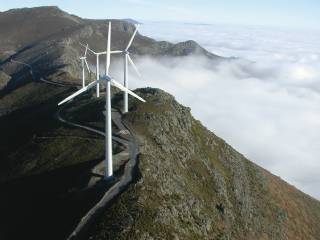
Landform is a key landscape characteristic, affecting whether it is rugged, flat, undulating or rolling, upland or lowland. In flat landscapes, any undulations tend to become accentuated so that even low hills appear substantial.
It is very difficult to design a wind farm upon a variable landform, such as undulating, rugged moorland or hills, without presenting a confusing image. This is because the wind turbines will be seen from different directions, at varying elevations and spacing, and against varying backdrops. To avoid this effect, it is generally preferable for wind turbines to be grouped on the most level part of a site so the development appears more cohesive, rather than as a poorly related group of turbines.
It is important to site and design a wind farm so that it appears visually balanced in relation to the underlying and surrounding landform. Turbines seen upon steep slopes often appear to be ‘unstable’. It is also important that the scale and extent of a wind farm do not seem to overwhelm the distinctive character and scale of a landform, especially prominent landforms. Single turbines are particularly challenging to site as they are often the only major vertical forms in the landscape.
Skylines are of critical importance. This is illustrated by the contrast between the simple, horizontal skylines of wide, flat landscapes and the more complex, vertical and diagonal components of skylines formed by mountains and hills. The viewer’s eye is naturally drawn to the skyline, although the extent to which this happens depends on the nature of the skyline, the distribution and type of other elements and foci within the scene. The skyline may be especially valued if it conveys a sense of wildness; forms the backdrop to a settlement; is a particularly distinctive landform, or where notable landmarks and/or cultural features appear on it.
Given the prominence of skylines, it is particularly important that a wind farm avoids, or is sited and designed to relate to them. A key challenge is that the skyline will vary in relation to the position and elevation of a viewer, and the weather. Nevertheless, the design of a wind farm from key viewpoints and routes should ensure it does not detract from the character of a distinctive skyline.
Care should be taken to ensure that the wind farm does not overwhelm the skyline. Distinctive and prominent skylines should not be interrupted by turbines. If the skyline is ‘simple’ in nature, for example over moorland and hills, it is important that wind turbines possess a simple visual relationship to this feature, avoiding variable height and spacing, the overlapping of turbines, or blade tips intermittently ‘breaking’ the skyline.
The landform may provide a design opportunity to limit visibility of wind turbines and site infrastructure. For example, where a wind farm is to be sited on a hill ridge, turbines may be set back from the edge and placed such that the slopes preclude visibility from below, reducing visual intrusion on the more settled lowlands, even if they may be clearly visible from adjacent hills. Narrow bands of uplands between settled and smaller-scale valleys should be avoided, if a windfarm on the hills would dominate the landscape on both sides.
Labels
different landformsdesert landformserosional landformssolar wind turbinewind turbine energy productionsmall wooden windmillFarming Principle: Deep Soil Preparation
Looking at GB as a three-legged stool, deep soil preparation is one of the legs. Deep soil preparation builds soil and soil structure by loosening the soil to a depth of 24 inches (60 cm). Ideal soil structure has both pore space for air and water to move freely and soil particles that hold together nicely.
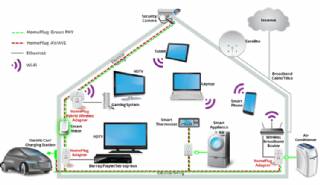
Smart Home Ecosystem - Smart Home Automation - Smart Home Security - Smart Home Technology
The outer-most level corresponds to the individual devices and sensors that consumers interact with. Several candidates are vying for the role of a leader introducing smart home services to the mass market.
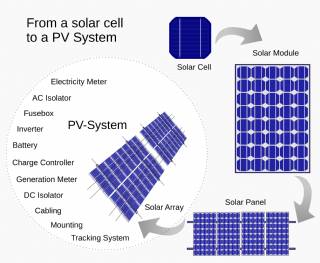
Solar Energy Systems - Solar Modules - Solar Electric System Design - Solar Power
The heart of a photovoltaic system is the solar module. Many photovoltaic cells are wired together by the manufacturer to produce a solar module. When installed at a site, solar modules are wired together in series to form strings. Strings of modules are connected in parallel to form an array.
Solar Energy Systems - Array Mounting Racks - Solar Ray - Solar Panel - PV Racks and Mounts
Arrays are most commonly mounted on roofs or on steel poles set in concrete. In certain applications, they may be mounted at ground level or on building walls. Solar modules can also be mounted to serve as part or all of a shade structure such as a patio cover. On roof-mounted systems, the PV array is typically mounted on fixed racks, parallel to t
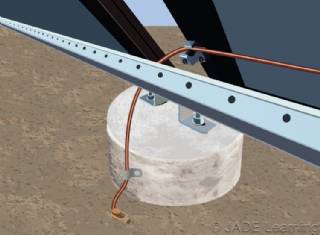
Solar Energy Systems - Grounding Equipment
Grounding equipment provides a well-defined, low-resistance path from your system to the ground to protect your system from current surges from lightning strikes or equipment malfunctions. Grounding also stabilizes voltages and provides a common reference point. The grounding harness is usually located on the roof.
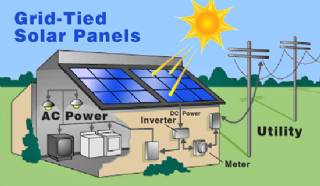
Solar Energy Systems - Solar Inverter - Solar Panel Inverter
Most grid-connected inverters can be installed outdoors, while most off-grid inverters are not weatherproof. There are essentially two types of grid-interactive inverters: those designed for use with batteries and those designed for a system without batteries.
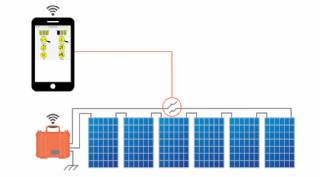
Solar Energy Systems - Solar Disconnects
Automatic and manual safety disconnects protect the wiring and components from power surges and other equipment malfunctions. They also ensure the system can be safely shut down and system components can be removed for maintenance and repair.
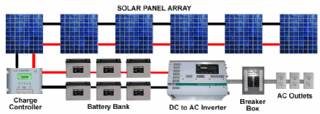
Solar Energy Systems - Solar Battery Bank
Batteries store direct current electrical energy for later use. This energy storage comes at a cost, however, since batteries reduce the efficiency and output of the PV system, typically by about 10 percent for lead-acid batteries. Batteries also increase the complexity and cost of the system.
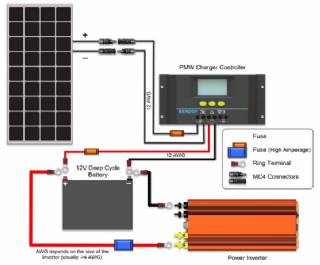
Solar Energy Systems - Solar Charge Controller
A charge controller, sometimes referred to as a photovoltaic controller or battery charger, is only necessary in systems with battery back-up. The primary function of a charge controller is to prevent overcharging of the batteries. Most also include a lowvoltage disconnect that prevents over-discharging batteries. In addition, charge controllers pr
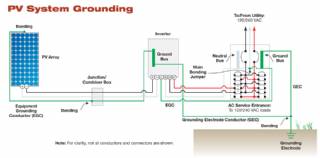
Solar Energy Systems - The NEC and PV Systems
Solar PV systems must be installed in accordance with Article 690 of the National Electric Code, which specifically deals with PV systems, as well as several other articles of the NEC that pertain to electrical systems in general. When there is a conflict between NEC 690 and any other article, NEC 690 takes precedence due to the unique nature of PV